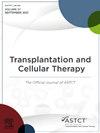多发性骨髓瘤自体造血细胞移植应用中的种族和民族差异在转诊至移植中心后仍长期存在。
IF 3.6
3区 医学
Q2 HEMATOLOGY
引用次数: 0
摘要
背景:尽管自体造血细胞移植(AHCT)用于治疗多发性骨髓瘤(MM)已有近40年的历史,而且即使在新型药物出现后,自体造血细胞移植仍是符合移植条件的MM患者的标准治疗方法,但自体造血细胞移植仍未得到充分利用,尤其是在少数种族和族裔人群中:作为多管齐下的努力的一部分,我们对2012年至2022年期间在学术移植中心就诊的所有MM新患者进行了机构审查,以计算AHCT的使用率,并调查与AHCT使用率相关的因素:研究设计:种族和民族为自我报告。基线特征按三组(非西班牙裔白人,NHW;非西班牙裔黑人,NHB;其他)进行分析。电子病历中记录了未接受 AHCT 的原因。多变量分析评估了组别对 AHCT 使用率的影响,并根据总体队列和咨询时间控制了与未接受 AHCT 的患者相关的协变量:在1266名患者中,13.4%为NHB。就诊时的中位年龄分别为 66(23-97)岁、66(23-97)岁、63(25-85)岁和 59.5(31-79)岁(P结论:随着时间的推移,种族和族裔的 AHCT 使用不足情况有所改善,但差距依然存在。就诊年龄较小、从诊断到就诊的时间较短、无心脏和肾脏并发症也与 AHCT 利用率有关。本文章由计算机程序翻译,如有差异,请以英文原文为准。
Racial and Ethnic Disparities in Autologous Hematopoietic Cell Transplantation Utilization in Multiple Myeloma Have Persisted Over Time Even After Referral to a Transplant Center
Despite the use of autologous hematopoietic cell transplantation (AHCT) in treatment of multiple myeloma (MM) for almost 40 years and its persistence as standard of care in transplantation-eligible patients with MM even after the advent of novel agents, AHCT remains underutilized, especially in racial and ethnic minority populations. As part of a multipronged effort to quantify disparities in AHCT utilization in MM by race and ethnicity and over time in our own cancer center, we conducted an institutional review of all new patients seen at an academic transplant center for consultation for MM between 2012 and 2022, to calculate AHCT utilization and investigate the factors associated with AHCT utilization. Race and ethnicity were self-reported. Baseline characteristics were analyzed in 3 groups: non-Hispanic White (NHW), non-Hispanic Black (NHB), and Others. Reasons for not undergoing AHCT in the EHR were recorded. Multivariate analyses evaluated the effect of group on AHCT utilization, controlling for covariates related to patients not undergoing AHCT by overall cohort and consult period. Of the 1266 patients, 13.4% were NHB. The median age at consult was 66 (IQR, 23-97) years overall, 66 (IQR, 23-97) years for NHWs, 63 (IQR, 25-85) years for NHBs, and 59.5 (IQR, 31-79) years for Others (P < .01). AHCT utilization was 76% overall, 64.7% in NHBs, 76.8% in Others, and 77.8% in NHWs (P < .01). Age, cytogenetics, stage, comorbidities, and time from diagnosis to consult were associated with receipt of AHCT. From 2012-2017 to 2018-2022, NHB AHCT utilization increased from 57.5% to 69.8% (P = .10). For those who did not receive AHCT, patient preference, older age, comorbidity, early mortality, and lack of caregiver support were the most frequently documented reasons. The NHW group had greater AHCT utilization compared to the NHB group (odds ratio [OR], 3.32; 95% confidence interval [CI], 2.17-5.08; P < .0001). Absent cardiac (OR, 1.88; 95% CI, 1.35-2.62; P = .0002) or renal comorbidity (OR, 3.23; 95% CI, 2.03-5.15; P < .0001) was associated with receipt of AHCT. Older age at consult (OR, .89; 95% CI, .87-.90; P < .0001) and longer time from diagnosis to consult (OR, .97; 95% CI, .95-.98; P < .0001) were associated with lower AHCT utilization. While AHCT utilization increased from 2012-2017 to 2018-2022 in NHBs compared to NHWs, it remained significantly lower. Racial and ethnic AHCT underutilization has improved over time, but disparities persist. Younger age at consult, shorter time from diagnosis to consult, and lack of cardiac and renal comorbidities also are associated with AHCT utilization.
求助全文
通过发布文献求助,成功后即可免费获取论文全文。
去求助
来源期刊

Transplantation and Cellular Therapy
Medicine-Hematology
CiteScore
7.00
自引率
15.60%
发文量
1061
审稿时长
51 days
 求助内容:
求助内容: 应助结果提醒方式:
应助结果提醒方式:


